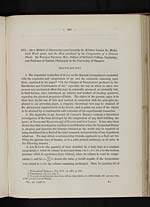Lord Kelvin (1824-1907)
On a method of discovering experimentally the relation between the mechanical work spent, and the heat produced by the compression of a gaseous fluid
(289)
XVI.—On a Method of Discovering experimentally the Relation between the Mecha-
nical Work spent, and the Heat produced by the Compression of a Gaseous
Fluid. By WILLIAM THOMSON, M.A., Fellow of St Peter's College, Cambridge,
and Professor of Natural Philosophy in the University of Glasgow.
(Read 21st April 1851.)
1. The important researches of JOULE on the thermal circumstances connected
with the expansion and compression of air, and the admirable reasoning upon
them, expressed in his paper* “On the Changes of Temperature produced by the
Rarefaction and Condensation of Air,” especially the way in which he takes into
account any mechanical effect that may be externally produced, or internally lost,
in fluid friction, have introduced an entirely new method of treating questions
regarding the physical properties of fluids. The object of the present paper is to
show how, by the use of this new method, in connection with the principles ex-
plained in my preceding paper, a complete theoretical view may be obtained of
the phenomena experimented on by JOULE; and to point out some of the objects
to be attained by a continuation and extension of his experimental researches.
2. The Appendix to my Account of CARNOT'S Theory† contains a theoretical
investigation of the heat developed by the compression of any fluid fulfilling the
laws ‡ of BOYLE and MARIOTTE and of DALTON and GAY LUSSAC. It has since been
shown that that investigation requires no modification when the Dynamical Theory
is adopted, and therefore the formula obtained as the result may be regarded as
being established for a fluid of the kind assumed, independently of any hypothesis
whatever. We may obtain a corresponding formula applicable to a fluid not ful-
filling the gaseous laws of density, or to a solid pressed uniformly on all sides, in
the following manner.
3. Let M dv be the quantity of heat absorbed by a body kept at a constant
temperature t, when its volume is increased from v to v +dv; let p be the uniform
pressure which it experiences from without, when its volume is v and its tempe-
rature t; and let p + dp/dt dt denote the value p would acquire if the temperature
were raised to t + d t, the volume remaining unchanged. Then, by equation (3) of
*Philosophical Magazine, May 1845, vol. xxvi., p. 369.
† Transactions, vol. xvi., part V.
‡ To avoid circumlocution these laws will, in what follows, be called simply, the gaseous laws,
or the gaseous laws of density.
VOL. XX. PART II.
41


